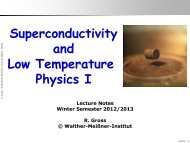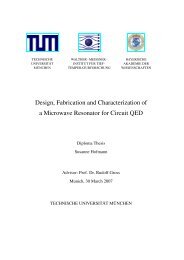Applied Superconductivity - Walther Meißner Institut - Bayerische ...
Applied Superconductivity - Walther Meißner Institut - Bayerische ...
Applied Superconductivity - Walther Meißner Institut - Bayerische ...
- No tags were found...
Create successful ePaper yourself
Turn your PDF publications into a flip-book with our unique Google optimized e-Paper software.
166 R. GROSS AND A. MARX Chapter 4result (3.3.8):〈V (t)〉 = I c R N√ ( I2I c) 2−( I m s (Φ ext2I c)√2 ( ) I 2 [ (= I c R N − cos π Φ )] 2ext. (4.1.34)2I c Φ 0The IVCs obtained according to this equation are shown in Fig. 4.4. It can be seen that the IVCs areperiodic with the applied magnetic flux with the periodicity of a single flux quantum. Considering thetime-averaged junction voltage as a function of the applied flux for different values of the bias current wesee that these curves are also periodic with the same periodicity. Furthermore, the minima and maxima ofthe 〈V 〉(Φ ext ) always appear at the same flux values. Fig. 4.4 also shows the cosπΦ ext /Φ 0 dependence ofthe zero voltage supercurrent through the SQUID. Furthermore, it is seen that the maximum modulationof the time-averaged voltage with varying applied flux occurs for I ≃ 2I c .Finite screening: β L ∼ 1, intermediate damping: β C ∼ 1For practical SQUIDs the inductance L of the loop containing the Josephson junctions must be takeninto account. As already discussed above, the loop area should be made large in order to increase theflux threading the SQUID at a given field value. However, a large loop area can not be obtained withoutincreasing the loop inductance. Furthermore, for typical Josephson junctions we cannot neglect thedisplacement current due to the finite junction capacitance as well as the fluctuating noise current. In thisgeneral case the dc-SQUID circuit is governed by a set of time-dependent nonlinear equations that mustbe solved numerically.The phase differences across the two junctions have to satisfy the following equations: 11,12,13V = Φ 04π( dϕ1dt+ dϕ )2dt2πn = ϕ 2 − ϕ 1 − 2π Φ extI2I2(4.1.35)− 2π LI cirΦ 0 Φ 0(4.1.36)= ¯hC d 2 ϕ 12e dt 2 + ¯h dϕ 1+ [I c sinϕ 1 + I cir ] + I F12eR N dt(4.1.37)= ¯hC2ed 2 ϕ 2dt 2 + ¯h dϕ 2+ [I c sinϕ 2 − I cir ] + I F2 . (4.1.38)2eR N dtEquation (4.1.35) relates the SQUID voltage to the rate of phase change. Note that for negligible screeningwe have dϕ 1dt= dϕ 2dtand the usual voltage-phase relation is recovered. For finite screening this isno longer the case and we have dϕ 1dt≠ dϕ 2dt. Equation (4.1.36) expresses the fluxoid quantization in thesuperconducting loop. We see that in contrast to negligible screening (compare (4.1.8)) we have to takeinto account also the flux LI cir due to the finite inductance of the loop. Equations (4.1.37) and (4.1.38)are Langevin equations coupled via I cir . These coupled equations have to be solved numerically underthe constraint given by (4.1.36) as a function of the screening parameter β L = 2LI c /Φ 0 , the Stewart-McCumber parameter β C = 2πI c R 2 N C/Φ 0 and the thermal noise parameter γ = 2πk B T /I c Φ 0 .11 C.D. Tesche, J. Clarke, dc-SQUID: Noise and Optimization, J. Low Temp. Phys. 27, 301 (1977).12 J.J.P. Bruines, V.J. de Waal, J.E. Mooij, J. Low Temp. Phys. 46, 383 (1982).13 V.J. de Waal, P. Schrijner, R. Llurba, Simulation and Optimization of a dc-SQUID with Finite Capacitance, J. Low Temp.Phys. 54, 215 (1984).© <strong>Walther</strong>-Meißner-<strong>Institut</strong>
















